
Htet Thiha Zaw examines if early history explains subsequent state presence in Bago, Myanmar.

In the Konbaung Kingdom, the state that existed before British colonial rule was an expansionist state that waged multiple wars with nearby territories of present-day China, Thailand, and India. To fund its war efforts, the state also engaged in extensive efforts to expand its revenue through administrative reforms, such as conducting land surveys and movement towards cash taxation (Lieberman, 1996). Such efforts implied a need for coordination with local town and village headmen (thugyis), who traditionally collected taxes and possessed information on local economic activities; the headman position was traditionally passed down via a hereditary line, and in fact many families ruled the localities for generations tracing back to Bagan dynasty (Trager and Koenig, 1979).
While the state did not abolish this hereditary mode of succession, an extinction of hereditary line due to the lack of a legitimate successor gave the state an opportunity to appoint their own headmen, according to land survey records (sit-tan) from 1784. I focus on this type of administrative change as an explanation for two reasons. First, local headmen played a key role as a state agent with local connections, and any opportunity to control them could have meaningful impact on the localities’ relations with the state. Second, the end of the hereditary line serves as an exogenous shock whose cause is independent of other local characteristics that may also affect their interaction with the Konbaung kingdom and British colonial rule, such as proximity to transport networks, factor endowments, ethnic compositions, and social structures. As a result, we can ensure that the villages where hereditary headman remained were different from those where headmen were appointed only in terms of hereditary leadership and not in terms of other factors that may also influence outcomes of interest. If this assumption does not hold, we cannot claim hereditary leadership as a cause for observed differences in outcomes of interest among the villages.
Figure 1 (below) shows the sit-tan extracts with information on local headmen. The image on the left showing records about a hereditary headman, and the image on the right showing a recently appointed headman.


How did this appointment change future relations between the localities and the state in the Konbaung period? I argue that the early co-option of the local headmen represents early state centralization, ensuring the state’s control over the locality and reducing the potential for contentious relations with the state. For the localities where hereditary headmen remained, however, centralization via control of local headmen did not come in until the arrival of the British rule (Note: the focus on Bago region is an advantage here as most of its territories were colonized at the same time in 1852, thereby making observations more comparable by timing of colonization). This variation in the timing of centralization throughout Burma is important because it influenced colonial administrators’ decisions on the priority of investments towards police stations, railways, post offices, schools, and hospitals. I argue that in the localities with early centralization, state attempts to control local headmen reduced the need for investment in the state’s monopoly of violence (the extent to which the state is responsible for coercion relative to other organizations), and therefore, the expansion of state presence focused on the development of welfare goods, such as schools and hospitals. Conversely, in the localities with late centralization, however, the expansion of state presence focused on the development of coercive goods, such as police outposts and military stations.
Do the existing historical findings support this proposed relationship between early modern history and local variation in colonial investment strategies? While historians have yet to present a direct evidence linking the two, a number of works on colonial administration have provided certain insights into the logic behind colonial investment. Hingkanonta (PhD Thesis, 2013), for example, argued that colonial police presence was concentrated in Lower Burma, and particularly in areas of economic importance or areas with high political disorder (p. 24). The latter areas were also subject to high levels of military police presence, employed during rebellions against the state (p. 9, 15). This coincided with the fact that Upper Burma was exposed to substantially higher levels of centralization under Konbaung rule, due to it being the core administrative zone of the state. Similarly, Crosthwaite’s details on police administration in colonial Burma suggested that local propensity to rebellion and dacoity was a key factor in deciding whether military police would be present, as evident in his decisions to keep military police in places “where the dacoits were most active and organized” (p. 97), and his request for military police during insurgent activities in Sagaing, Magwe, and Chindwin (p. 99). Therefore, while we do not have information on the role of early modern history on rebellion activity, we know that colonial investments, specifically in coercion, was motivated by local rebellion activity.
To find out how plausible the proposed theory is, I first estimate the effect of early centralization on the presence of particular types of institutions. Data on early centralization is available from land revenue inquest records (sit-tans) in 1784, conducted by the Konbaung state and translated by Trager and Koenig (1979). The respondents (local headmen) provided information on whether they succeeded the position via a hereditary line or they were recently appointed by the king. Drawing from colonial-era reports in 1912 on towns and villages that included information on the type of government buildings present (such as police outposts, military stations, railway stations, post offices, schools, and hospitals), I measure the density of military and police stations as the measure of coercive investments and the density of schools and hospitals as the measure of social welfare (social control) investments; densities care calculated by the number of relevant buildings divided by number of houses. Figure 3 shows the location of towns and villages recorded in 1784 after the appointment of village headmen began, and Figure 3 shows the location of towns and villages in colonial reports.
A note before summarizing the results is worth mentioning. Identifying schools and hospitals as social welfare (social control) investments is for the purpose of typification; there definitely needs an acknowledgement for their potential as modes of social control over local population (see Paglayan’s working paper on Chile for example). However, the assumption here is that access to education and healthcare may provide relatively more direct and tangible private benefits, such as access to higher education and more longevity.
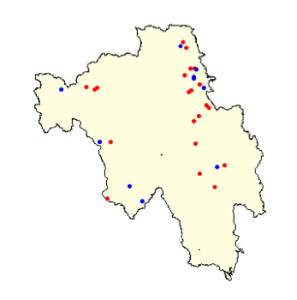
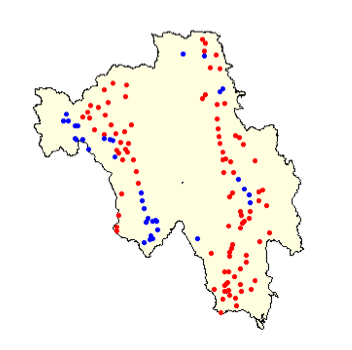
Estimation of the effect (Figure 4) using logit regression models shows that villages and towns that are closer to localities with early co-option of local headman by the state and before British colonial rule experienced lower density of coercive investments than those located closer to the localities with hereditary headmen until British colonial rule. While the density of social welfare investments is positive, high variance at most cutoff points means the relationship is weaker. These causal estimates are also robust to estimation at most of the different cutoff points, from 10 kilometers to 100 kilometers (maximum distance from historical towns and villages included in data) and removing noise from spatially correlated outcomes (as in the presence of one building in a town or village is correlated with the presence of the same building or other buildings in nearby towns and villages. The results therefore provide support to the theory; as the colonial state chose between the different types of investment, and prioritized the development of coercive investments in places where it needed most, such choices further limited the state’s ability to invest in other options such as schools and hospitals at the local level. This finding concurs with Hingkanonta’s argument, as local investment in coercion was driven by local rebellion activity, which I additionally argue, was influenced by the experience of early centralization under the Konbaung state.
An immediate concern here would be that these investments may be affected by other factors such as local economic development, proximity to trade networks, and distance from key urban centers such as Yangon. For example, regions of Bago that were closer to Konbaung state before British colonization of Upper Burma may have experienced more coercive state presence, as the regions were vulnerable to contention between local inhabitants and migrants from Upper Burma (Andrus, 1948, p. 65). Similarly, Bago region was a primary source for teak, which could also result in colonial investments patterns that vary by proximity to teak forest, as seen in Bryant’s (1997) detailed insights on the relationship between forestry and colonial rule in the region. Estimation of causal effects would be biased if the colonial towns and villages that are closer to historical locations where headmen were removed under Konbaung dynasty are systematically different in terms of such factors from those closer to locations whose headmen maintained hereditary lines from earlier periods of Konbaung dynasty. However, what the project can shed light on is, after controlling for all those other factors that may have affected local variation in colonial investments, if the historical variation in whether headmen were appointed under Konbaung rule can still explain the local variation in colonial investments.
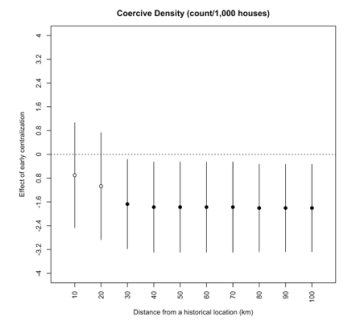
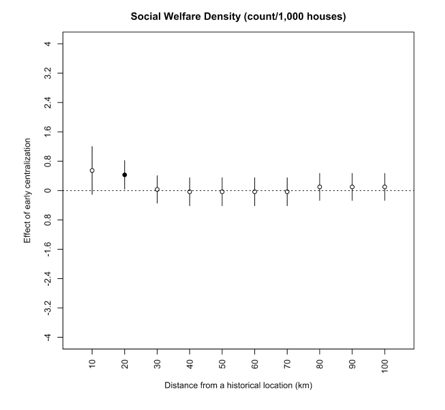
Control for political and economic characteristics take on two approaches. First, the effects account for district fixed effects, which are variables that proxy for different economic or political characteristics that may be explanations for colonial investments in police forces, schools , and hospitals at district level, such as ethnic composition, characteristics of the district commissioners, and level of urbanization. Second, the effects account for geographic controls that may affect colonial investments at town/village level. As a result, we can infer from the results whether it is plausible that early state control under Konbaung dynasty can explain the variation in colonial investment even when variations at district level and town/village level of numerous political and economic factors that may have affected the colonial state’s decision to invest are accounted for.
One may also argue that the two different types of state presence proposed here (coercive and social welfare) may correlate with overall state presence. For example, more coercive buildings, such as police stations, were constructed in the locations where other buildings, such as railway stations were also constructed. In order to address this, I estimate the relationship between the timing of centralization and the presence of other administrative buildings (including railway stations, post offices, bazaars, courts, and district/township offices). There seems to be no relationship between the two, meaning that the two types of relationships are not simply a reflection of overall state presence; the colonial government chose to make coercive investments in the places that had weaker links in the past, and more social welfare investments in the others.
How do these two different forms of colonial investment manifest themselves in post-colonial Myanmar? To investigate this, I use data from 50 years of armed conflicts (1948-1998), and 2016 geo-referenced data of government schools. The results (Figure 5) calculated at town and village tract level showed that proximity to the localities with early centralization is positively correlated with number of conflicts and negatively correlated with the number of government schools. These results suggest that the areas closer to localities with early co-option of local headmen not only received less coercive but also maintained a similar relationship with the post-colonial state to the present day that result in higher social welfare investment and lower political contention.
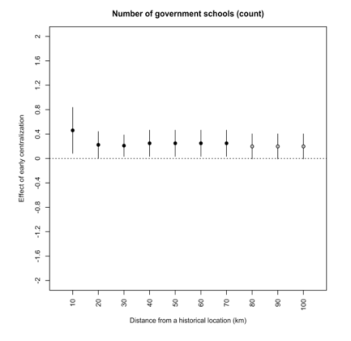
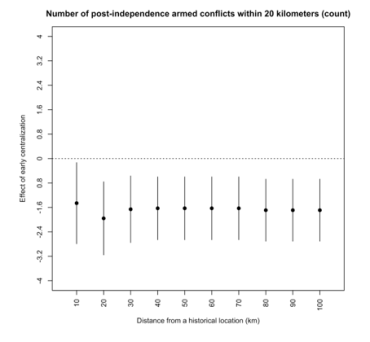
Scholars of Myanmar across different fields have produced numerous important works on the country, from colonial rebellions (Aung-Thwin, 2011) to post-colonial agricultural policies (Thawnghmung, 2004). However, this ongoing project shows one possible way of conducting quantitative analysis with political and economic data from Myanmar, as several existing studies have been limited to qualitative analyses and area studies, save for a few exceptions (Selway, 2015). This is unfortunate as the country provides numerous opportunities for quantitative research, especially for those interested in early modern and colonial history. Historical data sources on both the early modern period and colonial era data are numerous, and in addition, recent developments have produced numerous surveys and quantitative data to learn more about the country beyond the dominant modes of analysis. I expect future researchers of Myanmar to make good use of these opportunities and diversify the knowledge we have of the country.
Quantitative evidence so far provides support for the argument that early state control under Konbaung dynasty does affect the later colonial state’s priorities over coercive investments versus welfare investments. The project does not conclude here, however, as we still need qualitative evidence on whether the pre-existing village organization was a factor in making colonial investment decision. Further, possibly collaborative research on this by economists, political scientists, and historians will be a welcome addition to the much-needed knowledge about subnational variation in Myanmar’s political and economic history.
Htet Thiha Zaw is a PhD student in Political Science at the University of Michigan. His research interests lie in quantitative analyses of state building, institutional choice, and distributive politics, with a regional focus on Southeast Asia. His current research project explores the relationship between the early modern presence of hereditary chiefs and sub-national variations of inequality in Southern Myanmar. His personal website is https://sites.lsa.umich.edu/htzaw.
Like This Article
September 16, 2024
June 18, 2024
March 06, 2024
December 27, 2023

Center for Southeast Asian Studies, Asian Institute 1 Devonshire Place Toronto, Ontario, M5S 3K7, Canada
©TeaCircle All Rights Reserved 2023